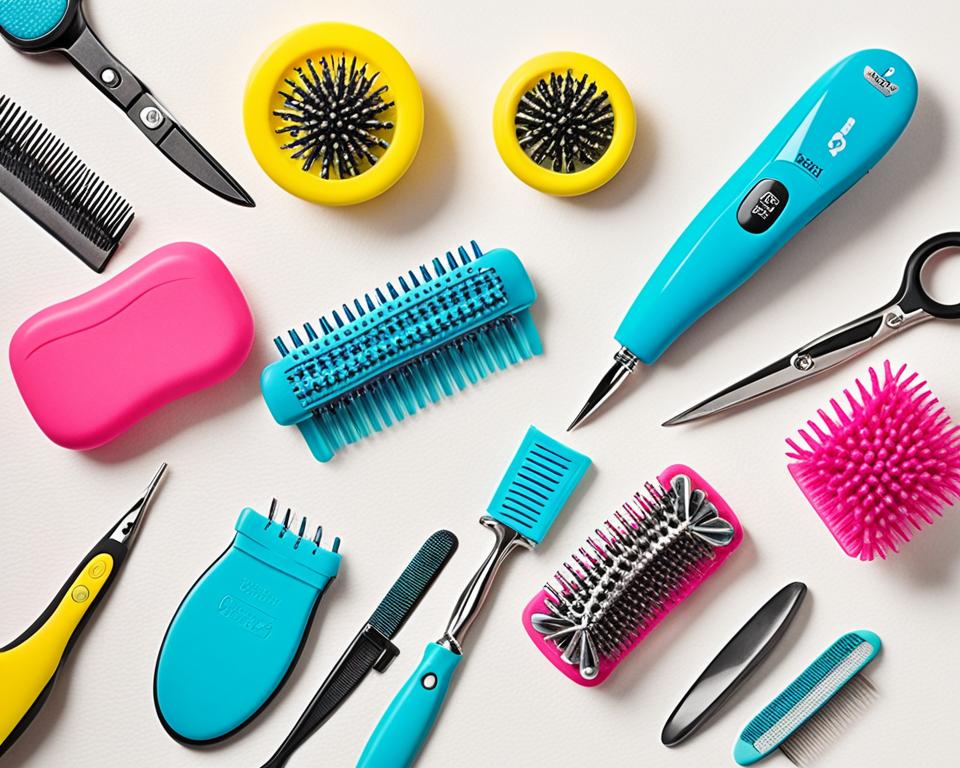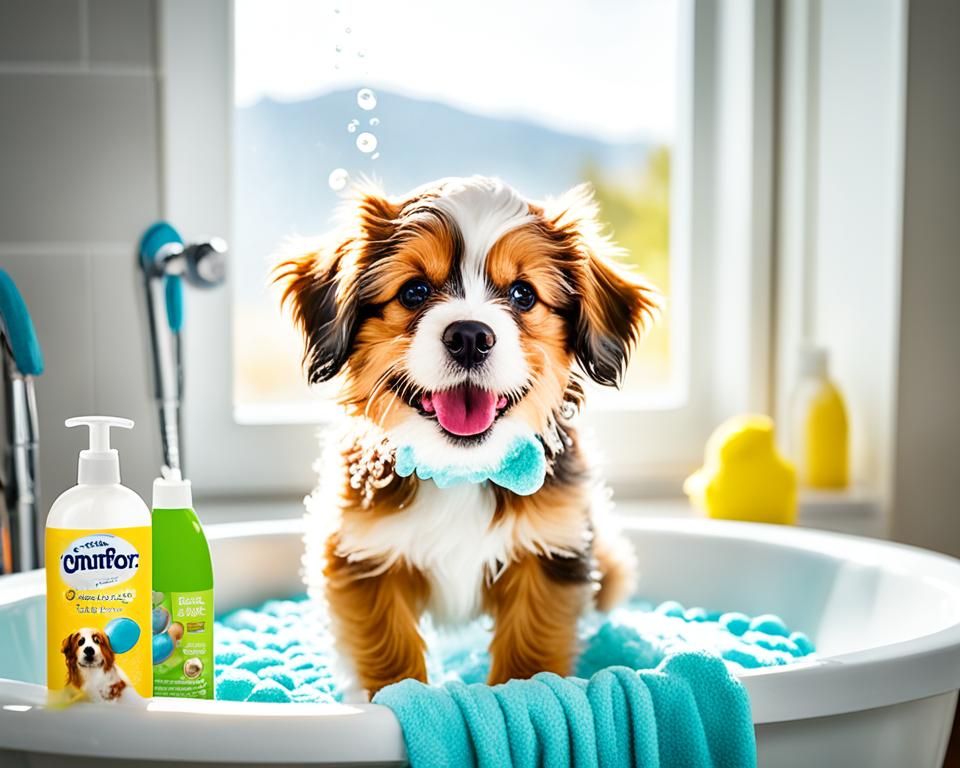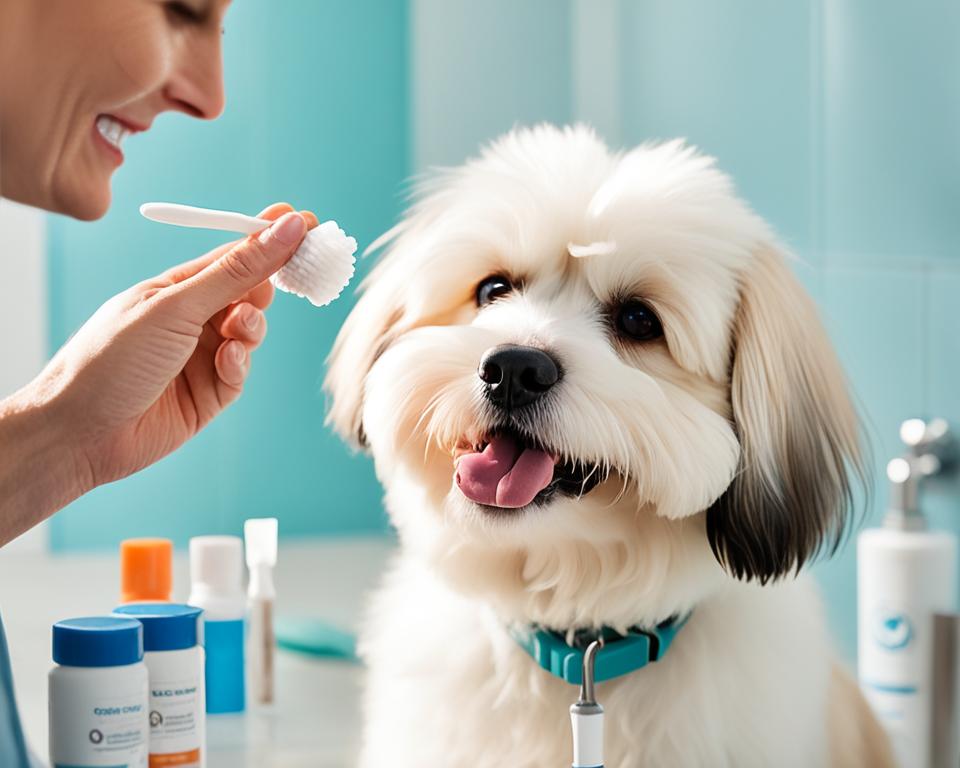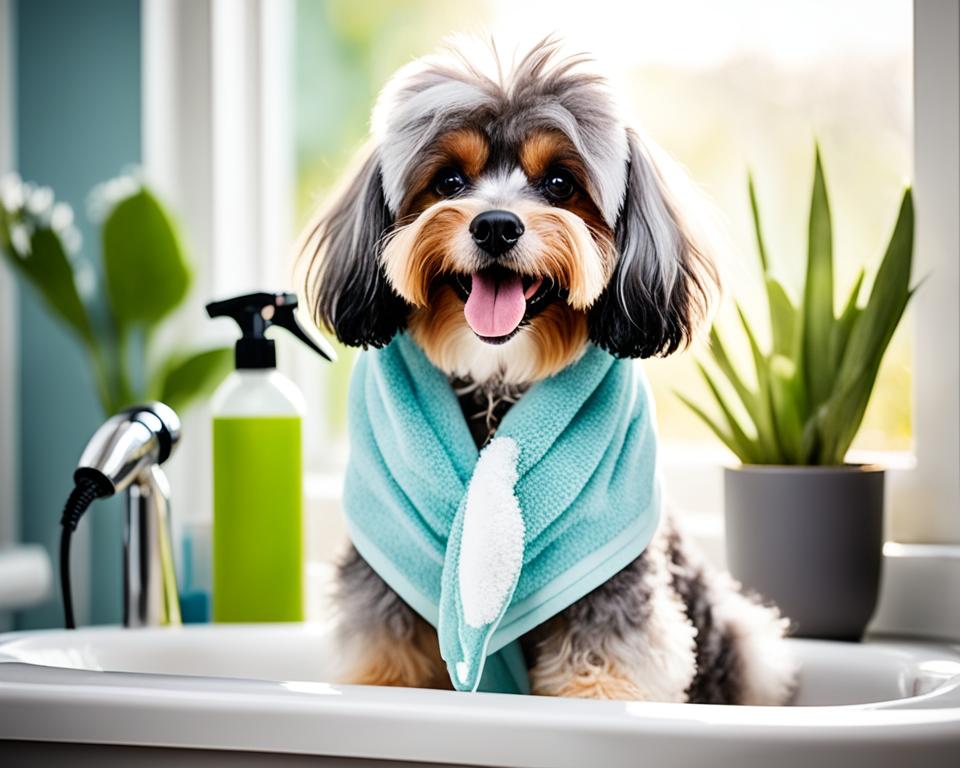Being a pet owner teaches us that grooming is key for our furry friends’ health and happiness. It’s not just about looks. Regular grooming helps dogs and cats stay well.
Pet care services are helpful, but we can groom at home too. For dogs and cats, being consistent is important. Brushing, bathing, and caring for them helps spot health problems early. It also makes our bond stronger.
In this guide, I’ll share tips I’ve learned. We’ll talk about choosing the right tools and grooming techniques. Let’s learn how to keep our pets happy, healthy, and looking great!
The Importance of Regular Pet Grooming
Regular pet grooming is key to keeping pets healthy and clean. As a pet owner, I’ve seen many grooming benefits. These go way beyond just making my pet look good.
Maintaining Healthy Skin and Coat
Brushing is crucial for a healthy coat. It gets rid of dirt, dandruff, and dead hairs. It also stops tangles and mats. Regular brushing makes my pet’s fur shiny and healthy.
Early Detection of Health Issues
Grooming lets me check my pet’s skin closely. I can find problems like ticks, fleas, or dry spots early. Professional groomers can spot health issues I might miss. This means quicker and better treatment.
Strengthening the Human-Pet Bond
Grooming is a special time for us. It’s about touching and caring for each other. Starting grooming early with young pets makes it easier later on.
| Grooming Task | Frequency | Benefits |
|---|---|---|
| Brushing | Daily to weekly | Removes dirt, prevents tangles, distributes oils |
| Bathing | As needed (consult vet) | Cleans coat, refreshes skin |
| Nail Trimming | Monthly | Prevents injuries, eases joint pain |
| Teeth Brushing | Daily to weekly | Prevents periodontal disease |
Regular grooming has made a big difference in my pet’s health. It’s not just for looks. It’s a key part of caring for pets. It helps them live happy, healthy lives.
Essential Grooming Tools for Your Furry Friend
I love pampering my furry friend, and the right grooming tools help a lot. Whether you’re grooming at home or getting ready for a salon, these tools will keep your pet looking great.

First, you need brushes. For short-haired pets, a bristle brush is perfect. Long-haired pets need a slicker brush for tangles. And, a de-shedding tool helps with loose hairs.
Next, nail clippers are a must. They prevent overgrown nails, which can hurt your dog. Always have styptic powder ready, just in case.
For baths, use dog-specific shampoo and conditioner. They’re kind to the skin and make coats shine. After washing, use absorbent towels or a pet dryer to dry them off. Did you know 50% of long-haired dog owners use dryers for drying?
Don’t forget about dental care. Only 20% of pet owners brush their dog’s teeth often. I’m one of the proud ones! A toothbrush and pet-safe toothpaste are key for clean teeth.
| Grooming Tool | Price Range | Usage |
|---|---|---|
| Brushes | $23.99 – $45.99 | Daily coat maintenance |
| Nail Clippers | $29.99 – $59.99 | Regular nail trimming |
| Pet Dryer | $79.99 – $129.00 | Post-bath drying |
| Dental Kit | $24.99 – $39.99 | Daily teeth cleaning |
With these tools, you’re ready for some quality time with your pet. Remember, 85% of pet owners see grooming as a way to bond. So, grab your tools and start grooming!
Brushing Techniques for Different Coat Types
I’m excited to share my pet grooming tips for various coat types. Whether you’re into dog grooming or cat grooming, the right technique can make a big difference. Let’s dive into the best brushing methods for different furry friends!
Short-Haired Breeds
For short-haired pups like Pugs, I use a rubber brush once a week. The Kong Dog ZoomGroom works wonders! It’s gentle yet effective for removing loose hair and keeping their coat shiny. For Labrador Retrievers with short double coats, I apply medium to firm pressure with the KONG ZoomGroom weekly.
Long-Haired Breeds
Long-haired beauties like Bichon Frises need extra attention. I brush them a few times a week with a slicker brush, such as the Hertzko Self-Cleaning Slicker Brush. This prevents mats and keeps their coat lustrous. For breeds with silky coats, like Irish Setters, daily brushing is key.
Curly and Wavy Coats
Curly-coated breeds like Poodles require daily brushing. I use a slicker brush followed by a metal comb to prevent matting. These breeds benefit from professional grooming every 4-6 weeks and baths every 2-3 weeks. For wavy coats, I recommend brushing several times a week to keep them tangle-free.
| Coat Type | Brushing Frequency | Bathing Frequency | Professional Grooming |
|---|---|---|---|
| Short-haired | Once a week | Every 4-6 weeks | 2-3 times a year |
| Long-haired | Daily | Every 3-4 weeks | Every 2-3 months |
| Curly/Wavy | Daily to several times a week | Every 2-3 weeks | Every 4-6 weeks |
Remember, regular pet grooming not only keeps your furry friend looking great but also strengthens your bond. Happy brushing!
Bathing Your Pet: Best Practices and Frequency
Bathing is key to keeping pets clean. The right frequency depends on your pet’s breed, coat, and lifestyle. Dogs should be bathed at least once every three months, says the ASPCA. But, bathing too much can harm their skin by removing natural oils.

When bathing, I use lukewarm water and shampoo made for pets. Human shampoo can make their skin worse. Before bathing, I brush them to get rid of loose hair and dirt. This makes bathing easier.
Here’s how I bathe my pet:
- Wet your pet thoroughly
- Apply shampoo and massage gently
- Avoid eyes and ears
- Rinse completely
- Towel dry or use a low-setting hairdryer
It’s good to reward your pet during and after the bath. This makes them like the experience more. Pets like Shar Peis or Pugs need extra care to avoid skin problems.
If you’re not sure about bathing your pet, consider pet care services. They can give you advice and help with bathing and other grooming tasks.
Nail Care: Trimming and Maintenance
Looking after your pet’s nails is very important. I keep my pet comfy and healthy by trimming their nails often. Let’s look at the basics of nail care for your pet.
Proper Nail Trimming Techniques
Choosing the right tools is crucial for nail trimming. I use pet-specific clippers or grinders. It’s vital to trim nails bit by bit, avoiding the quick. For dogs with black nails, I get help from a pro to be extra careful.
Addressing Anxiety During Nail Trims
Many pets get stressed during nail trims. I start early and use positive rewards to help. For really nervous pets, I do one nail at a time over a few days. This slow method really helps them feel less stressed.
Benefits of Regular Nail Care
Regular nail care has many benefits for your pet:
- Prevents overgrowth and ingrown nails
- Reduces risk of nail splitting and tearing
- Improves mobility and comfort
- Helps maintain proper paw posture
I trim my pet’s nails every 3-4 weeks, depending on their growth and activity level. Remember, taking good care of your pet’s nails is key to their health and happiness.
| Nail Care Frequency | Benefits | Precautions |
|---|---|---|
| Every 3-4 weeks | Prevents overgrowth, Improves mobility | Avoid cutting the quick |
| Every 7-10 days (with Dremel) | Maintains nail length, Reduces anxiety | Introduce gradually |
| As needed for dewclaws | Prevents tearing, Reduces discomfort | Trim carefully, Seek professional help if unsure |
Ear Cleaning and Dental Hygiene for Pets

Keeping pets clean is key for their health. Regular ear and dental care stop serious health problems. These steps are vital for our furry friends.
How often to clean ears depends on the pet. Some dogs don’t need cleaning, but others do. I look for discharge or smell to know when to clean. If I see redness or swelling, I talk to my vet first.
Brushing teeth daily helps prevent dental disease. Bad oral health can cause infections and affect the heart and kidneys. I use special toothpaste and a brush for my pet’s teeth.
“Regular dental care can improve a pet’s quality of life and promote longevity.”
Here’s a quick guide to keeping your pet’s ears and teeth healthy:
| Task | Frequency | Tools Needed |
|---|---|---|
| Ear Cleaning | As needed, based on discharge or odor | Pet-specific ear cleaner, cotton balls |
| Teeth Brushing | 3 times a week (ideally daily) | Pet toothbrush, pet toothpaste |
| Dental Chews | Daily | Vet-approved dental chews or toys |
Getting professional help is a big plus. I go to my vet regularly for ear and dental check-ups. Sometimes, I choose professional grooming for a deep clean.
Pet Grooming: Professional vs. DIY Approaches
I often think about the good and bad of grooming pets myself or by a pro. Many pet owners, like me, do a bit of both. Let’s look at why professional grooming is great, how to groom at home, and when to get expert help.
Benefits of Professional Grooming
Professional groomers give special care that’s tough to get at home. They know how to handle different pets and have the best tools. Most pets need professional grooming every 6-8 weeks. Here’s why I take my pet to a salon:
- Expert detection of health issues
- Safe and efficient nail trimming
- Thorough flea and tick removal
- Relaxing pet massages
Tips for Successful Home Grooming
Grooming at home can save money and be fun. In fact, 64% of pet owners like doing it themselves. Here are some tips I’ve learned:
- Invest in quality grooming tools
- Establish a regular grooming routine
- Create a calm environment
- Learn proper techniques for your pet’s coat type
When to Seek Professional Help
Even though I like grooming my pet at home, there are times I get help from pros. Consider getting help for:
- Complex grooming needs or breed-specific cuts
- Anxious or uncooperative pets
- Matted fur or excessive shedding
Mobile pet grooming is great for busy owners. It brings professional care right to your home. This way, you get the best care without leaving your house.
| Aspect | Professional Grooming | DIY Grooming |
|---|---|---|
| Cost | Higher per session | Lower ongoing costs |
| Time Investment | Less time-consuming | More time-consuming |
| Expertise | High level of expertise | Requires learning and practice |
| Convenience | Appointment-based | Flexible scheduling |
Dealing with Matted Fur and Excessive Shedding
Many pet owners face the challenge of matted fur and too much shedding. These problems can be tough, but there are ways to handle them. Matted fur usually happens where skin rubs against skin, like under the legs and behind the ears.
For matted fur, I suggest using a dematting tool made for pets. The Magic Coat® Pro de-Matting Tool is excellent for getting rid of mats and dead hair. If mats are really bad, getting help from a professional groomer is best.
Regular brushing is key to stop mats before they start, especially for long-haired dogs like Poodles and Bichon Frisés. To deal with too much shedding, brush your pet more often during the shedding season.
What your pet eats also affects their shedding and coat health. Keeping up with grooming routines that fit your pet’s coat type really helps. For dogs that easily get mats, like Doodles and Bearded Collies, brushing every day might be needed.
Pet grooming is more than making your pet look good. It’s a key part of keeping them healthy and happy.

